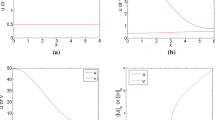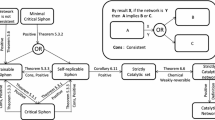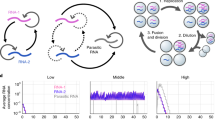Abstract
It is shown that in a flow reactor, hypercyclic coupling of self-reproducing macromolecular species leads to cooperation, i.e. none of the concentrations will vanish. On the other hand, autocatalytic selfreproducing macromolecules usually compete, and the number of surving species increases with the total concentration. Both results are proved under very general assumptions concerning the growth rates.
Similar content being viewed by others
References
Eigen, M.: Selforganization of matter and the evolution of biological macromolecules. Naturwissenschaften 58, 465–526 (1971)
Eigen, M., Schuster, P.: The hypercycle: A principle of natural self-organization, Part A: Emergence of the hypercycle. Naturwissenschaften 64, 541–565 (1977)
Eigen, M., Schuster, P.: The hypercycle: A principle of natural self-organization, Part B: The abstract hypercycle. Naturwissenschaften 65, 7–41 (1978a)
Eigen, M., Schuster, P.: The hypercycle: A principle of natural self-organization, Part C: The realistic hypercycle. Naturwissenschaften 65, 341–369 (1978b)
Eigen, M., Schuster, P., Sigmund, K., Wolff, R.: Elementary step dynamics of catalytic hypercycles. Biosystems 13, 1–22 (1980)
Epstein, I. R.: Competitive coexistence of self-reproducing macromolecules. J. Theor. Biol. 78, 271–298 (1979a)
Epstein, I. R.: Coexistence, competition and hypercyclic interaction in some systems of biological interest. Biophys. Chem. 9, 245–250 (1979b)
Feinberg, M.: Mathematical aspects of mass action kinetics. In: Chemical reactor theory (L. Lapidus, N. R. Amundson, eds.), pp. 1–78. Englewood Cliffs, N. J.: Prentice-Hall Inc. 1977
Hofbauer, J., Schuster, P., Sigmund, K.: A note on evolutionary stable strategies and game dynamics. J. Theor. Biol. 81, 609–612 (1979)
Hofbauer, J., Schuster, P., Sigmund, K., Wolff, R.: Dynamical systems under constant organization, Part II: Homogeneous growth functions of degree P = 2. SIAM J. Appl. Math. C38, 282–304 (1980)
Jones, B. L., Enns, R. H., Ragnekar, S. S.: On the theory of selection of coupled macromolecular systems. Bull. Math. Biol. 38, 15–28 (1976)
Küppers, B. O.: Towards an experimental analysis of molecular self-organization and precellular Darwinian evolution. Naturwissenschaften 66, 228–243 (1979)
Küppers, B. O., Sumper, M.: Minimal requirement for template recognition by bacteriophage Qβ replicase: Approach to general RNA-dependent RNA synthesis. Proc. Nat. Acad. Sci. U.S.A. 72, 2640–2643 (1978)
Maynard-Smith, J.: The theory of games and the evolution of animal conflicts. J. Theor. Biol. 47, 209–221 (1974)
Schneider, F. W., Neuser, D., Heinrichs, M.: Hysteretic behaviour in poly(A)-poly(U) synthesis in a stirred flow reactor. In: Molecular mechanisms of biological recognition (M. Balaban, ed.), pp. 241–252. Amsterdam: Elsevier North-Holland Biomedical Press 1979
Schuster, P., Sigmund, K.: A mathematical model of the hypercycle. In: Synergetics (H. Haken, ed.). Proceedings of a Conference in Bielefeld, September 1979, (1980)
Schuster, P., Sigmund, K., Wolff, R.: Dynamical systems under constant organization, Part I: A model for catalytic hypercycles. Bull. Math. Biology 40, 743–769 (1978)
Schuster, P., Sigmund, K., Wolff, R.: Dynamical systems under constant organization, Part III: Cooperative and competitive behaviour of hypercycles. J. Differential Equations 32, 357–368 (1979)
Spiegelmann, S.: An approach to the experimental analysis of precellular evolution. Q. Rev. Biophys. 4, 213–253 (1971)
Sumper, M., Luce, R.: Evidence for de novo production of self-replicating and environmentally adapted RNA structures by bacteriophage Qβ replicase. Proc. Nat. Acad. Sci. U.S.A. 72, 162–166 (1975)
Taylor, P., Jonker, L.: Evolutionary stable strategies and game dynamics. Math. Biosc. 40, 145–156 (1978)
Thompson, C. J., McBride, J. L.: On Eigen's theory of self-organization of matter and evolution of biological macromolecules. Math. Biosc. 21, 127–142 (1974)
Zeeman, E. C.: Population dynamics from game theory. Proc. Int. Conf. on Global Theory of Dynamical Systems, Northwestern University, Evanston, 1979
Author information
Authors and Affiliations
Additional information
This work has been supported by the Austrian Fonds zur Förderung der Wissenschaftlichen Forschung, Proj. No. 3502
Rights and permissions
About this article
Cite this article
Hofbauer, J., Schuster, P. & Sigmund, K. Competition and cooperation in catalytic selfreplication. J. Math. Biology 11, 155–168 (1981). https://doi.org/10.1007/BF00275439
Revised:
Issue Date:
DOI: https://doi.org/10.1007/BF00275439




